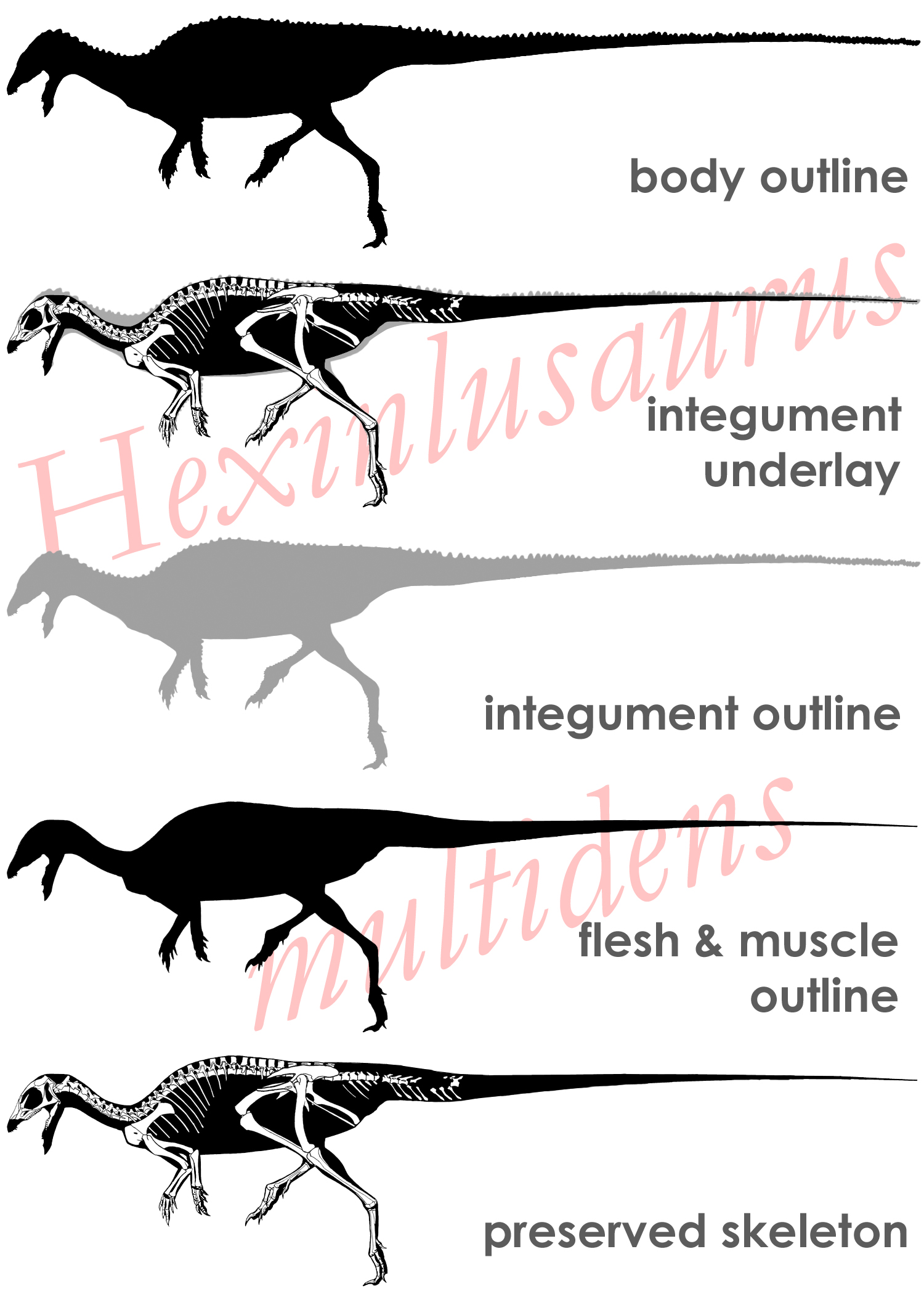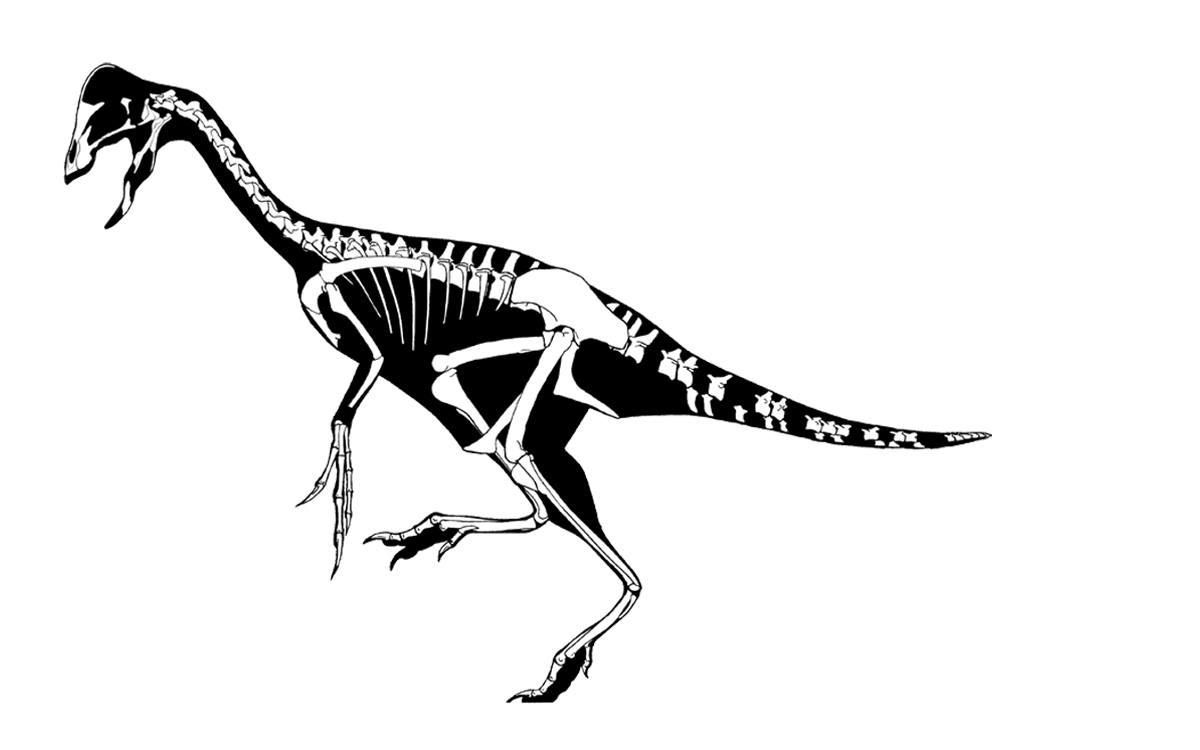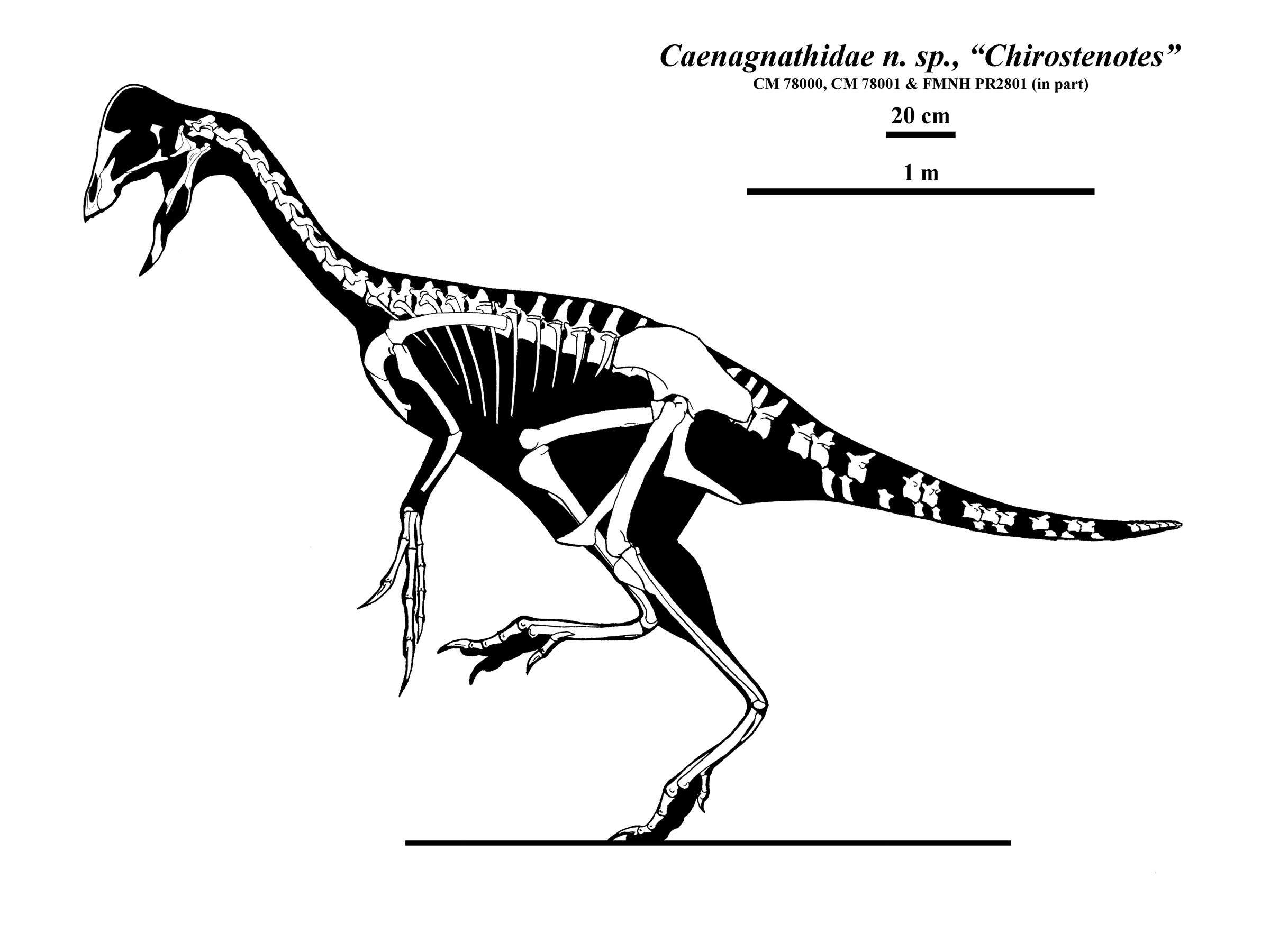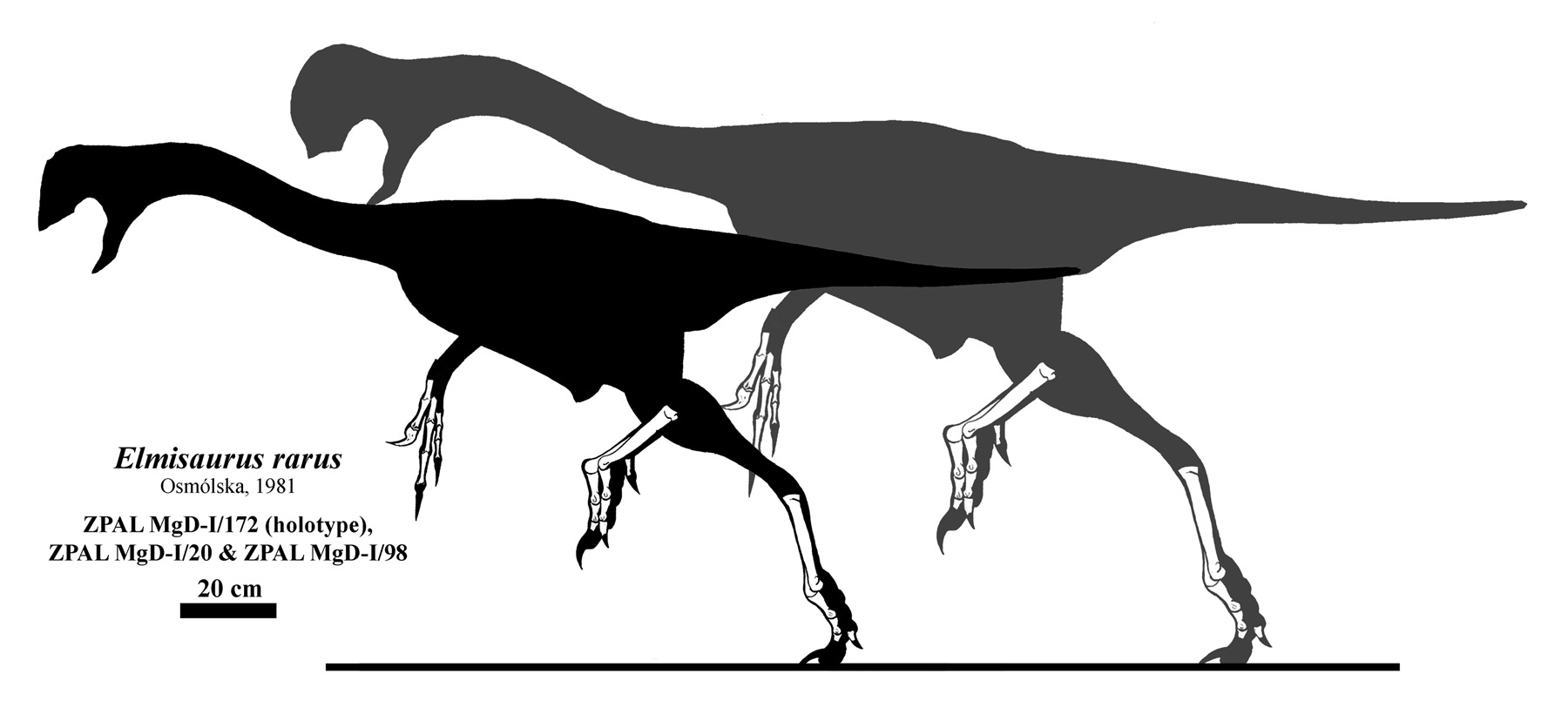






Skeleton of Anzu wyliei Lamanna, Sues, Schachner & Lyson, 2014. Drawn after Scott Hartman’s and thus a complete ripoff. Modifications will be made at some point with new data now published. Manus and pes are not as complete as illustrated. 
Skeleton of Ajancingenia yanshini, including the holotype braincase, manus and pes (MPC-D 100/30), paratype mandible and limbs (MPC-D 100 31). Due to the nature of the issues surrounding consistency of the holotype, only the figured limb material and skull is shown, but substantive vertebral and rib material is known. 




Skeleton of Huanhepterus quingyangensis. 

[Skeletal diagram is CC-BY: You are free to distribute, modify, and otherwise mess with this illustration, so long as any presentation of this cites me as the original source.] 
Revision of Waterhouse’s comparisons, with UCMP 143274 in white in silhouettes of a [skinned] psittaciform-like bird (including zygodactylous foot), and a small caenagnathid-like nonavian dinosaur. 
Skeletons in silhouettes of Elmisaurus, showing Elmisaurus rarus based on ZPAL MgD-I/172 and 98; B, Elmisaurus rarus, projected size of ZPAL MgD-I/20; C, Elmisaurus elegans, based on ROM 781. Scale bar equals 50cm. 
A generalized skeleton in lateral view of a chaoyangopterid, in the Habib quad launch position, body horizonal. Skull is mostly illustrated from Shenzhouopterus chaoyangensis (Lü et al., 2008). 


My only copy of my skeleton of Heterodontosaurus tucki, based mostly on SAM PK K1332. 

The name will eventually be changed, but this really is Hexinlusaurus multidens, I swear! 

An outdated reconstruction of Longisquama insignis (Sharov, 1970), with the limbs held in an erect, potentially terrestrial posture. (I no longer agree with this interpretation.) 

Skeleton of Nemegtomaia barsboldi Lü et al. (2004), based only on the holotype MPC-D 100/2112. 
The “Triebold Oviraptorosaurs”, based on CM 78000 and CM 78001. Known material presumes a nearfly complete vertebral column across both specimens, with large sections of vertebrae from each individual represented. 

Achillobator giganticus, a particularly robust dromaeosaurid. 
Skeleton of Carnotaurus sastrei Bonaparte, 1986. 
Skeleton of Spinosaurus aegyptiacus von Stromer, 1917, based on the holotype IPHG (BSP) 1912 VIII 19. 
Skeleton of Scleromochlus taylori in multiple views. 
Scansoriopterygidae, including all referred taxa. Scansoriopteryx heilmanni is often considered synonymous with Epidendrosaurus ningchengensis, both are probably juveniles, and they may in turn be synonymous with Epidexipteryx hui (in which case Scansoriopteryx heilmanni has priority above both other taxa). 
IVPP V15471, holotype of Epidexipteryx hui Zhang et al., 2008. 
Caenagnathid skeletons. NMC 2467 is the holotype of Chirostenotes pergracilis Gilmore, 1924, while NMC 8538 is the holotype of Macrophalangia canadensis Sternberg, 1932, which is considered by most authors along with RTMP 79.20.1, to be Chirostenotes pergracilis. 
Skeleton of STM 27-2, holotype of Xiaotingia zhengi Xu et al., 2011. Grey areas are reconstructed from severely-damaged bone in the braincase region. Lengths of the tibia and metatarsus are reconstructed, as are the conjoining ends, which are not preserved. 
Skeleton of GI 100/42, possibly a new taxon. 
MPC-D 100/1201(formerly, GI SPS 100/51), holotype of Homalocephale calathocercos Maryaska and Osmólska (1974). 
Skeletal reconstruction of AMNH FR 6514, holotype of Oviraptor philoceratops Osborn (1924). Shown are all preserved material. 
Skeletons of Macelognathus vagans. The larger skeleton indicates YPM 1415, the holotype, while the smaller one is represented from several specimens described by Göhlich et al. (2005) and scaled to the largest of them after Terrestrisuchus gracilis and another “sphenosuchian,” Hallopus victor. Both are shown in a high-stepping trot. 
Hallopus victor, YPM 1914, in all its incomplete but leggy glory. Much of the skeleton is comprised of negative impressions, which I normally shade in grey; here, because some of them are partially filled in bone, I’ve chosen to take the cheater’s route and show all of it in “true bone” white. 
Skeleton of Terrestrisuchus gracilis in a high trot. That jaw really should be shut. 
Rahonavis ostromi Forster et al. (1998), based on the holotype UA 8656. 
The saltasaurid titanosaurian sauropod, Opisthocoelicaudia skarzynskii Borsuk-Białynicka, 1977. 
Leptoceratops gracilis, rendered after several referred and the type specimens, but likely improperly scaled due to rendering after composite illustrations and a few independent bones. 
Jeholopterus ningchengensis. 
Skeletal diagrams for Archaeoceratops oshimai (top) and Leptoceratops gracilis (bottom). 
Unenlagiidae, showing the two largest and two smallest members. 
GI 100/42. 
Limusaurus inextricabilis, Xu et al., 2009, based on IVPP V15923 (holotype). 
Silhouettes of Spinosaurus aegyptiacus. 
Composite skeleton of oviraptorid when it was mounted in the Dino Kingdom Nakasato in Nakasato, Japan. 

Caenagnathidae, comparison of various known skeletal material. 
Skeletons in silhouette of Elmisaurus rarus. 
t 
Nyctosaurus, projecting the possible presence of a soft-tissue crest between the elongated branches of the bifurcate crest (he shown longer on the horizontal ramus than in the above illustration). A narrow-chord wing is projected based on discussions from various authors, although some other authors have argued against such a wing in generally all pterosaurs. 
Sinornithosaurus millennii and “Dave” compared. 
Goyocephale lattimorei [1], holotype skeleton. 
Skeletons of Suchomimus tenerensis (top) and Baryonyx walkeri (bottom) compared. Note the ridiculous disparity in length between the authorship lists. 
Skeleton of Majungasaurus crenatissimus (=Majungatholus atopus). Based mostly on FMNH PR2100. 
Skeleton of Protarchaeopteryx robusta, based on the holotype NGMC 2127. 
Skeletons of Caudipteryx. Top left, Cauipteryx zoui, based on NGMC 97-4 and 97-9; top left, Caudipteryx dongi, based on IVPP v?; bottom,. Caudipteryx sp. based on IVPP V?. Scale bar represents ten centimeters. Skeletons are all to scale. 
The “Sphenosuchian” Terrestrisuchus gracilis, one of the earlier “dog-crocs.” 
The Archaeopteryx specimens, scaled left to right from largest to smallest.
The Author
-

This work is licensed under a Creative Commons Attribution-NonCommercial-NoDerivs 3.0 Unported License. It, and all of its files and contents -- unless otherwise noted -- are protected by this license.License established 9/9/2012, while previously I was using a CC-BY-ND license instead.
I have two websites, my DeviantArt and RedBubble accounts, which allow downloads and purchase of the imagery presented on this site. As I am a starving artist, I would appreciate support this way.
-
Join 2,869 other subscribers

